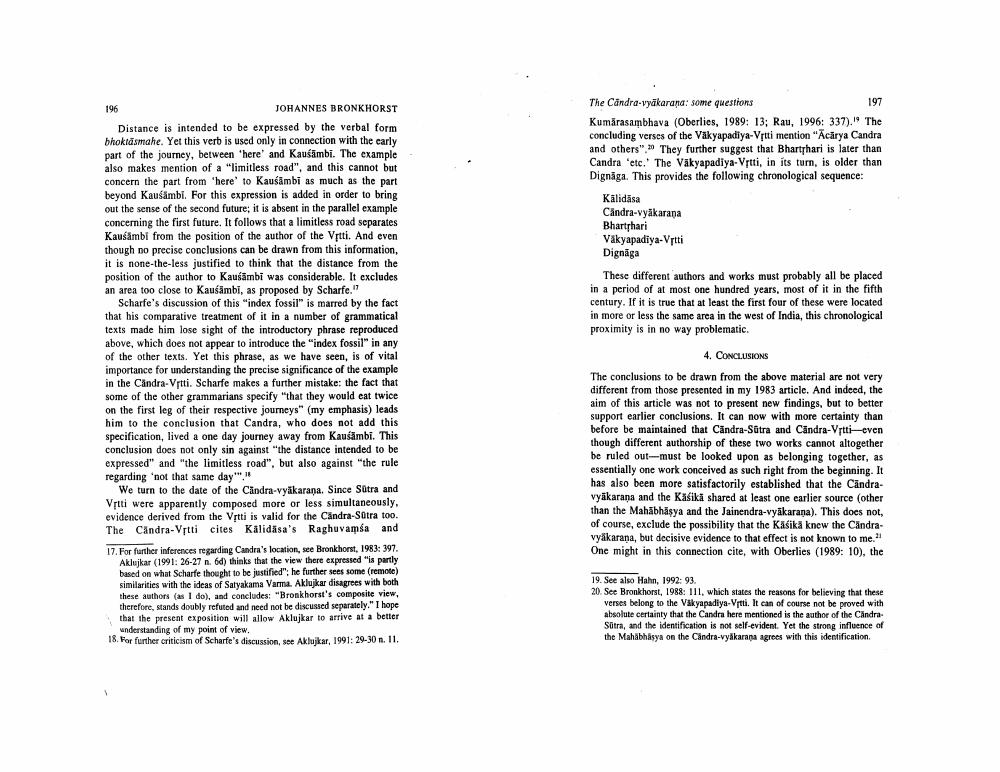Book Title: Candra Vyakarna Some Questions Author(s): Johannes Bronkhorst Publisher: Johannes Bronkhorst View full book textPage 8
________________ 196 JOHANNES BRONKHORST Distance is intended to be expressed by the verbal form bhoklāsmahe. Yet this verb is used only in connection with the early part of the journey, between 'here' and Kauśambi. The example also makes mention of a "limitless road", and this cannot but concern the part from 'here' to Kausämbi as much as the part beyond Kausambi. For this expression is added in order to bring out the sense of the second future; it is absent in the parallel example concerning the first future. It follows that a limitless road separates Kausambi from the position of the author of the Vṛtti. And even though no precise conclusions can be drawn from this information, it is none-the-less justified to think that the distance from the position of the author to Kausāmbi was considerable. It excludes an area too close to Kausāmbi, as proposed by Scharfe." Scharfe's discussion of this "index fossil" is marred by the fact that his comparative treatment of it in a number of grammatical texts made him lose sight of the introductory phrase reproduced above, which does not appear to introduce the "index fossil" in any of the other texts. Yet this phrase, as we have seen, is of vital importance for understanding the precise significance of the example in the Candra-Vrtti. Scharfe makes a further mistake: the fact that some of the other grammarians specify "that they would eat twice on the first leg of their respective journeys" (my emphasis) leads him to the conclusion that Candra, who does not add this specification, lived a one day journey away from Kausāmbi. This conclusion does not only sin against "the distance intended to be expressed" and "the limitless road", but also against "the rule regarding 'not that same day""" We turn to the date of the Candra-vyäkarana. Since Sütra and Vṛtti were apparently composed more or less simultaneously, evidence derived from the Vṛtti is valid for the Cändra-Sütra too. The Candra-Vrtti cites Kalidasa's Raghuvamsa and 17. For further inferences regarding Candra's location, see Bronkhorst, 1983: 397. Aklujkar (1991: 26-27 n. 6d) thinks that the view there expressed "is partly based on what Scharfe thought to be justified"; he further sees some (remote) similarities with the ideas of Satyakama Varma. Aklujkar disagrees with both these authors (as I do), and concludes: "Bronkhorst's composite view, therefore, stands doubly refuted and need not be discussed separately." I hope that the present exposition will allow Aklujkar to arrive at a better understanding of my point of view. 18. For further criticism of Scharfe's discussion, see Aklujkar, 1991: 29-30 n. 11. The Candra-vyäkarana: some questions 197 Kumarasambhava (Oberlies, 1989: 13; Rau, 1996: 337). The concluding verses of the Vakyapadiya-Vrtti mention "Acarya Candra and others". They further suggest that Bharthari is later than Candra etc. The Vakyapadiya-Vṛtti, in its turn, is older than Dignaga. This provides the following chronological sequence: Kālidāsa Candra-vyākarana Bharthari Vakyapadiya-Vrtti Dignaga These different authors and works must probably all be placed in a period of at most one hundred years, most of it in the fifth century. If it is true that at least the first four of these were located in more or less the same area in the west of India, this chronological proximity is in no way problematic. 4. CONCLUSIONS The conclusions to be drawn from the above material are not very different from those presented in my 1983 article. And indeed, the aim of this article was not to present new findings, but to better support earlier conclusions. It can now with more certainty than before be maintained that Cändra-Sütra and Candra-Vrtti-even though different authorship of these two works cannot altogether be ruled out-must be looked upon as belonging together, as essentially one work conceived as such right from the beginning. It has also been more satisfactorily established that the Candravyakarana and the Käsikä shared at least one earlier source (other than the Mahabhaṣya and the Jainendra-vyäkarana). This does not, of course, exclude the possibility that the Käsikä knew the Candravyäkarana, but decisive evidence to that effect is not known to me." One might in this connection cite, with Oberlies (1989: 10), the 19. See also Hahn, 1992: 93. 20. See Bronkhorst, 1988: 111, which states the reasons for believing that these verses belong to the Vakyapadlya-Vitti. It can of course not be proved with absolute certainty that the Candra here mentioned is the author of the CandraSütra, and the identification is not self-evident. Yet the strong influence of the Mahabhasya on the Candra-vyäkarana agrees with this identification.Page Navigation
1 ... 6 7 8 9 10
